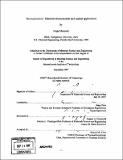Thermoelectrics : material advancements and market applications
Author(s)
Monreal, Jorge
DownloadFull printable version (7.314Mb)
Other Contributors
Massachusetts Institute of Technology. Dept. of Materials Science and Engineering.
Advisor
Gang Chen.
Terms of use
Metadata
Show full item recordAbstract
Thermoelectric properties have been known since the initial discovery in 1821 by Thomas Seebeck, who found that a current flowed at the junction of two dissimilar metals when placed under a temperature differential. This was followed by the discovery in 1834 by John Peltier, that the inverse was also true. That is, that a current applied to two dissimilar metals would yield a temperature differential. Interest in thermoelectrics laid dormant for almost 100 years and were primarily a laboratory curiosity. That interest was revived in the early 1900s with applications for remote power generation aboard satellites and several military applications. Thermoelectric devices, such as beverage coolers or thermocouples for temperature sensors, that tried to make use of these characteristics shortly followed. However, commercial success soon slowed down as efficiencies of the materials were not conducive to profitability. The effectiveness of a thermoelectric was described by a dimensionless figure of merit given by ZT=(S2a/ke+kp)T, where S is the Seebeck coefficient, T is the operational temperature, a is the electrical conductivity, ke is the electron contribution to thermal conductivity, and kp is the thermal conductivity due to phonon propagation across a crystal lattice. From the mid-1940s until the 1970s there was very slow progress in increased thermoelectric material efficiency, which culminated in a ZT=1 with (Bi2Te3). For approximately 30 years progress stagnated. In 1993, however, new ideas emerged that called for the fabrication of low dimensional structures to enhance electron conductivity while inhibiting phonon contribution to thermal conductivity. Advancements in material efficiency have made great progress since then. (cont.) Businesses are, once again, looking at thermoelectrics for potential commercial ventures. This thesis will begin with an examination of the theory behind thermoelectric properties, followed by an explanation of the methods used to assess thermoelectric device and material performance. It will then review some of the advancements made in low dimensional structures such as two-dimensional structures of quantum wells, one-dimensional nanowires, and zero-dimensional quantum dots. A market analysis of current commercial applications is presented. A proposed business model exploiting the power generation mode of thermoelectric devices is introduced. And, finally, an overview of the intellectual property landscape describes several patents relevant to the proposed business model.
Description
Thesis (M. Eng.)--Massachusetts Institute of Technology, Dept. of Materials Science and Engineering, 2007. Includes bibliographical references (leaves 77-78).
Date issued
2007Department
Massachusetts Institute of Technology. Department of Materials Science and EngineeringPublisher
Massachusetts Institute of Technology
Keywords
Materials Science and Engineering.